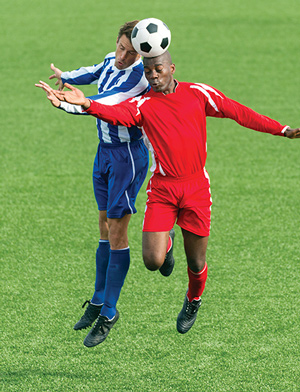 By Jordana Bieze Foster
By Jordana Bieze Foster
Postural control deficits in concussed athletes remain long after their clinical symptoms have resolved, and earlier return to activity exacerbates those lingering effects, according to research presented in May at the annual meeting of the American College of Sports Medicine (ACSM) in San Diego.
In an investigation done at Campbell University in Buies Creek, NC, a multicenter team of researchers assessed static and dynamic postural control in seven concussed college athletes and 11 controls at four time points: 24 to 48 hours, eight days, 15 days, and 22 days after injury. Peak center of pressure velocity was measured during quiet stance (static) and while athletes played the Wii Fit Soccer Heading game (dynamic).
All of the concussed athletes were cleared by their treating physicians to return to sports by the eight-day time point. However, significant differences in static postural control between concussed athletes and controls persisted at eight days, and dynamic differences persisted at day 15 and day 22.
“One regret we had was that we didn’t keep going, to see how long these effects lasted,” said Douglas Powell, PhD, director of the Advanced Interdisciplinary Movement Science Laboratory at the university, who presented the findings at the ACSM meeting.
Researchers from Georgia Southern University in Statesboro followed 18 concussed athletes for 30 days following injury and compared them with 10 controls using linear and nonlinear measures of postural control in conjunction with the Balance Error Scoring System. Linear measures (95% area, mean velocity) differed significantly between groups at 24 to 48 hours after injury, but the nonlinear measure of approximate entropy (a measure of gait predictability) differed significantly at the time of return to play and at 30 days postinjury.
“Is approximate entropy indicative of premature return to play, or risk of injury? We don’t know, but it’s something we need to look at further,” said Kelsey M. Evans, MS, a graduate student at the university, who presented the findings at the ACSM meeting.
Research from the University of Michigan in Ann Arbor suggest concussion may have even longer-lasting effects on gait, particularly under challenging conditions. When crossing an obstacle during gait, toe clearance, hip external rotation, and trail foot knee extension differed significantly between eight college-aged participants with a history of concussion (the average time from injury was 5.7 years) and eight controls with no similar history. Similar trends were observed when a cognitive task was added to the obstacle-crossing protocol, although the differences between groups were not statistically significant.
“The concussion group may be using a more proactive strategy,” said Douglas Martini, PhD, a graduate research assistant at the university, who presented the findings at the ACSM meeting. “The question is, how does this affect these people as they age? Do the differences become greater, and does that put them at a greater risk of injury?”
Findings reported at the ACSM meeting by researchers from Boston Children’s Hospital appear to illustrate the potential risks associated with premature return to sports following a concussion. Investigators assessed center of mass (COM) motion during gait in 29 athletes (mean age 15.4 years) two months following a concussion. Time to return to activity averaged 23.9 days, but ranged from five to 57 days.
The investigators found that the day of return to activity was significantly associated with COM mediolateral displacement and COM velocity during dual-task gait.
“Those who returned earlier performed worse at two months than those who returned later,” said David R. Howell, PhD, ATC, a postdoctoral research fellow at the hospital, who presented the findings.
Sources:
Murray NG, Salvatore AP, Powell D, Reed-Jones RJ. Evaluation of static and dynamic postural control in athletes with concussions during recovery. Med Sci Sports Exerc 2015;46(5 Suppl);S571.
Evans KM, Li L, Munkasy BA, et al. Linear and non-linear as measurements of postural control recovery following concussion. Med Sci Sports Exerc 2015;46(5 Suppl);S570.
Martini D, Goulet GC, Gates D, et al. A preliminary investigation: Long-term effects of concussion on obstacle crossing. Med Sci Sports Exerc 2015;46(5 Suppl);S570.
Howell DR, Osternig LR, Christi AD, Chou L-S. Return to activity timing is associated with dual-task gait stability two months after concussion. Med Sci Sports Exerc 2015;46(5 Suppl);S571.








